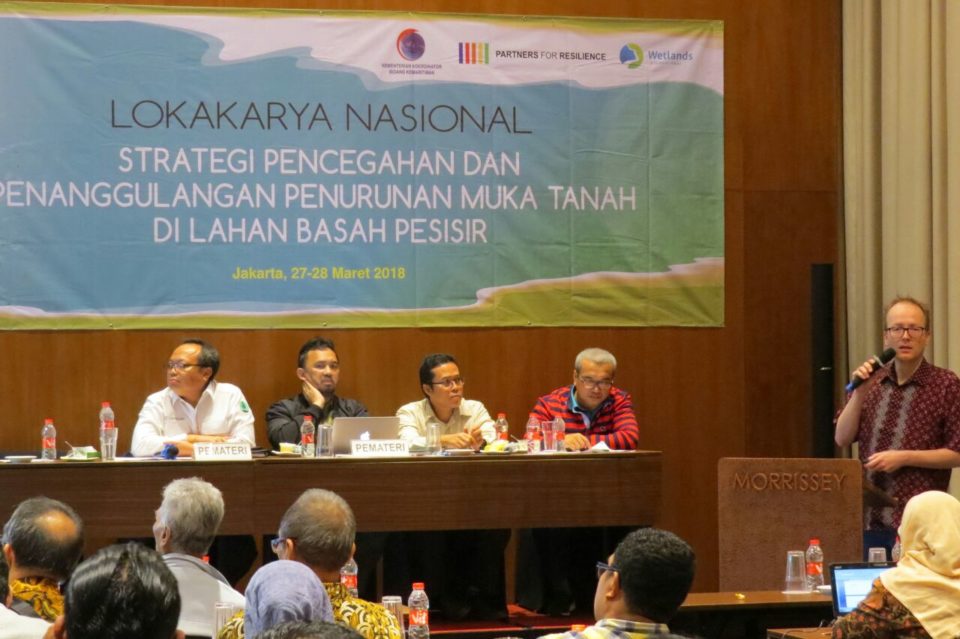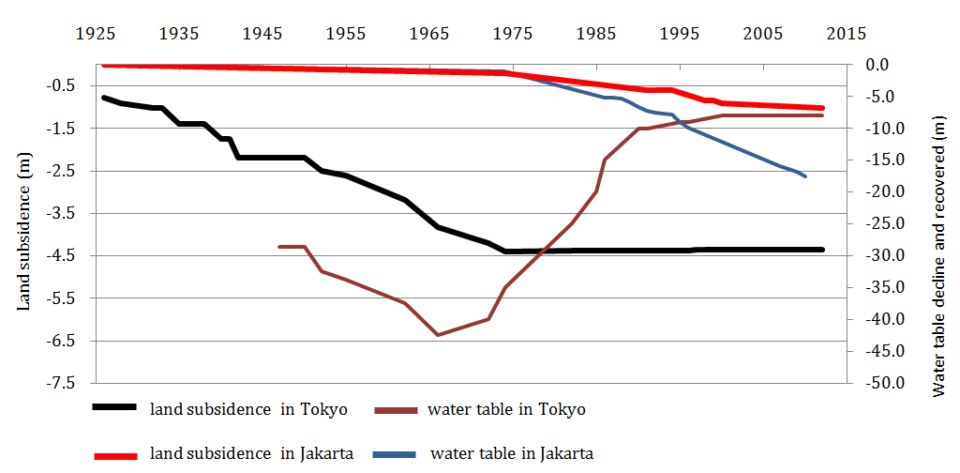
First national workshop held in Indonesia to address land subsidence problems
-
Coastal resilience
-
Coastal wetland conservation
-
Integrated delta management
On 27–28 March a national seminar was held in Jakarta on the urgent issue of land subsidence in coastal lowlands which is increasingly affecting coastal communities with flooding and erosion problems throughout Indonesia. This was the first time that a large number of ministries, agencies, knowledge institutes and civil society organisations came together to discuss the causes and solutions for this emerging disaster.
The seminar, organised by the Ministry of Maritime Affairs, Wetlands International and the Partners for Resilience alliance, concluded with a Land Subsidence Declaration which calls for urgent control of ground water extraction and peatland drainage, wetland-friendly development, and a joint roadmap for regional and national government levels to mitigate land subsidence.
Issue to be forwarded to Ministerial and President levels
Ir. Agung Kuswandono, M.A., Deputy II for Coordination of Natural Resources and Services, Coordinating Ministry for Maritime Affairs, conveyed, “After this seminar, I am reporting and taking this land subsidence issue to the Minister, to be further forwarded to the President. I am sure that we have budget to address the problems, it is just that the many efforts that has been undertaken by so many parts of our nation, be it the government, NGOs, and the private sector are still segregated, and yet need to be mainstreamed. Therefore, we need a roadmap to empower all the existing Government Regulations and achieve our wetlands restoration objectives”.

Without action land subsidence may cause flooding and loss of land
Land subsidence occurs when water is extracted from the earth’s crust, lowering the land surface downward potentially even below river or sea level. Indonesian coastal lowlands, such as mangroves, peatland, river estuaries and lagoons which are estimated to cover a total of 30 million hectares, consist of important wetland ecosystems situated mostly at an elevation of around 30 meters above sea level. Drainage and conversion of wetlands for establishment of housing areas, fish ponds, plantations, industrial development, and infrastructure, and massive extraction of ground water from coastal wetlands are amongst the main caused of land subsidence.
Unless there is action to reduce the pace or stop it, land subsidence will continue and increase flooding and loss of land, which affects people that live and work in low-lying areas, but also companies active in these areas.
Severe subsidence problems in Northern Java and coastal peatlands
Land subsidence is for example apparent in the northern coast of Java, with rates between 1-25 cm annually. In this area, where Wetlands International works with public and private partners to restore the eroded mangrove coast, the high subsidence levels may have reached a threshold in some places where coastal restoration and aquaculture revitalisation may no longer be feasible unless subsidence is stopped.
In coastal peatlands, land subsidence is also a major problem, caused by excessive peatland drainage through canalization for palm oil or acacia plantations. “What is not realized by many is that actually the biggest stock of freshwater in Indonesia is not in the rivers or lakes, but is, in fact, in peatlands,” states Nyoman Suryadiputra, Director of Wetlands International Indonesia, when addressing his keynote speech in the beginning of the seminar.
Land subsidence and sea level rise combined lead to disaster
At the same time, impacts from global climatic change is causing sea level raise. Combined, both processes become a potential cause of coastal disaster, which Indonesia already experienced in many parts of the country in the past years. The problem calls for integrated disaster risk, coastal zone and water management, climate change scenarios, investments in sustainable ecosystem management and restoration, and empowering local people to develop sustainable livelihoods. This can only be done by mapping current and future water demands, availability and water safety, and through dialogue.
Control of ground water extraction
When similar problems were detected in Tokyo in 1975, the Japanese government immediately controlled the extraction of ground water. Data shows there is correlation between discontinuation of ground water extraction and land subsidence rate, both in Tokyo and in Jakarta,” explained Dr. Heri Andreas, Geodetic expert from ITB.

Correlation between ground water table and land subsidence in Tokyo vs. in Jakarta. In the context of Tokyo, it is apparent that when all regulations to control urban and industrial ground water extraction are reinforced, the water table was gradually increased, and the land subsidence rate eventually stopped. Source: Dr. Heri Andreas, Land Subsidence of Pantura.ppt, delivered at the National Seminar on Land Subsidence, 27–28 March 2018.
Land subsidence declaration to accelerate joint action
By the end of the seminar, the organisers issued a Land Subsidence Declaration to mitigate land subsidence, which reflects consensus among participants about a series of steps to be taken in an effort to reduce or halt the rate of land subsidence:
- control of ground water extraction, in urban, industrial and rural areas
- regulations that stop ground water extractions need to be combined with management of demand and enhanced surface water use which requires integrated water resources management and planning
- implementation of environmentally-friendly development
- control over peatland canalization and
- the development of a roadmap for the regional and national levels to anticipate and mitigate land subsidence in an integrated and consistent way
For further information, contact:
- Susan Lusiana, Project Coordinator Partners for Resilience, Wetlands International Indonesia, e-mail: [email protected]
- Maulyati Nuraini Slamet, Policy Advocacy and Communications Coordinator, Wetlands International Indonesia, e-mail: [email protected]
